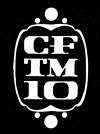CFTM-DT
CFTM-DT, virtual and VHF digital channel 10, is the flagship station of the French-language TVA television network, licensed to Montreal, Quebec, Canada. The station is owned by the Groupe TVA subsidiary of Quebecor Media. CFTM-DT's studios are located on Boulevard de Maisonneuve East and Rue Alexandre de Sève in the Ville-Marie borough of Montreal, and its transmitter is located on Voie Camillien Houde (near Mount Royal). On cable, the station is available on Vidéotron Illico digital cable channel 4 in standard definition and channel 604 in high definition in the Montreal area; Vidéotron also offers a three-hour delayed feed to Illico subscribers on channel 401.
 | |
| Montreal, Quebec Canada | |
|---|---|
| Channels | Digital: 10 (VHF) (to move to 11 (VHF)) Virtual: 10.1 (PSIP) |
| Branding | TVA (general) TVA Nouvelles (newscasts) |
| Slogan | Diffuseur d'émotions |
| Programming | |
| Affiliations | TVA (O&O) |
| Ownership | |
| Owner | Groupe TVA inc.[1] |
| History | |
| First air date | February 19, 1961 |
| Former affiliations | Independent (1961–1971) |
| Call sign meaning | CF Télé-Métropole |
| Technical information | |
| Licensing authority | CRTC |
| ERP | 11 kW |
| HAAT | 296.8 m (974 ft) |
| Transmitter coordinates | 45°30′20″N 73°35′30″W |
| Links | |
| Website | TVA |
History

It opened on February 19, 1961, a few weeks after CFCF-TV went on the air for the first time. It was owned by Joseph Alexandre de Sève and his company, Télé-Métropole. At first it relied primarily on kinescopes from RTL, and also from Télé Monte Carlo, but it wasn't long before it settled into a more peculiar and local form. On April 14, 1963, CFTM started sharing programs with CJPM-TV in Chicoutimi (now Saguenay) in the Saguenay–Lac-Saint-Jean region on the day the latter station signed on. They were joined by CFCM-TV in Quebec City in 1964. This was the informal beginning of TVA, though the network wasn't officially established until September 12, 1971. When de Sève died in 1968, the city government renamed the street in front of CFTM's studios rue Alexandre de Sève in his honour.
CFTM has always been by far the largest station in the TVA network. As such, it dominated the network long before Télé-Métropole bought majority control of TVA in 1990. At one point, CFTM produced as much as 90 percent of TVA's programming. Even today, TVA's network feed is little more than a retransmission of CFTM. Whenever CFTM has to interrupt its programming for breaking news or weather alerts in Montreal, the entire network usually gets interrupted as well.
CFTM-TV was essentially available on satellite beginning November 1, 1981 as TCTV, carried via Cancom by cable television operators across Canada, though not in most major cities. TCTV carried mainly the same programs as CFTM, but with some local news and programming from other TVA affiliates.
The TCTV service ended when the Canadian Radio-television and Telecommunications Commission (CRTC) approved TVA for a national network license in 1998. Since May 1, 1999, all Canadian cable companies have been required to carry a TVA station. CFTM is the affiliate carried in most markets outside of Quebec — excepting some markets in Northern Ontario, Eastern Ontario and New Brunswick, which have long carried the stations in adjacent markets. The station also provides a time-shifted feed for cable companies in western Canada, delayed three hours after the original broadcast, matching up with Pacific Time.
Digital television and high definition
CFTM received CRTC approval in March 2006 for its request to broadcast digitally on UHF channel 59[2] and was granted a requested extension to August 31, 2009 to launch this service but the launch never occurred.[3] On July 6, 2009, as part of a license renewal hearing, TVA was granted a second extension in which to launch CFTM-DT.
During the analogue television shutdown and digital conversion, which took place on August 31, 2011,[4] CFTM silenced its analogue transmitter on September 1, 2011 at 12:01 am during a movie's airing and began broadcasting a digital signal a few minutes later on its old analog channel number, 10.
References
- Ownership Chart 156A – QUEBECOR – TV & Discretionary Services
- Broadcasting Decision CRTC 2006–78, 15 March 2006, re: TVA Group Inc, Montréal, Québec
- Broadcasting Public Notice 2008-0050-0 17 March 2008, approval of extension to 31 August 2009 to commence operation of transitional digital television at CFTM-TV Montréal
- "Archived copy". Archived from the original on 2008-09-16. Retrieved 2012-03-15.CS1 maint: archived copy as title (link)
External links
- Official website

- CFTM-DT history – Canadian Communications Foundation
- CFTM at TV Hat
- CFTM-DT in the REC Canadian station database
- Query TV Fool's coverage map for CFTM